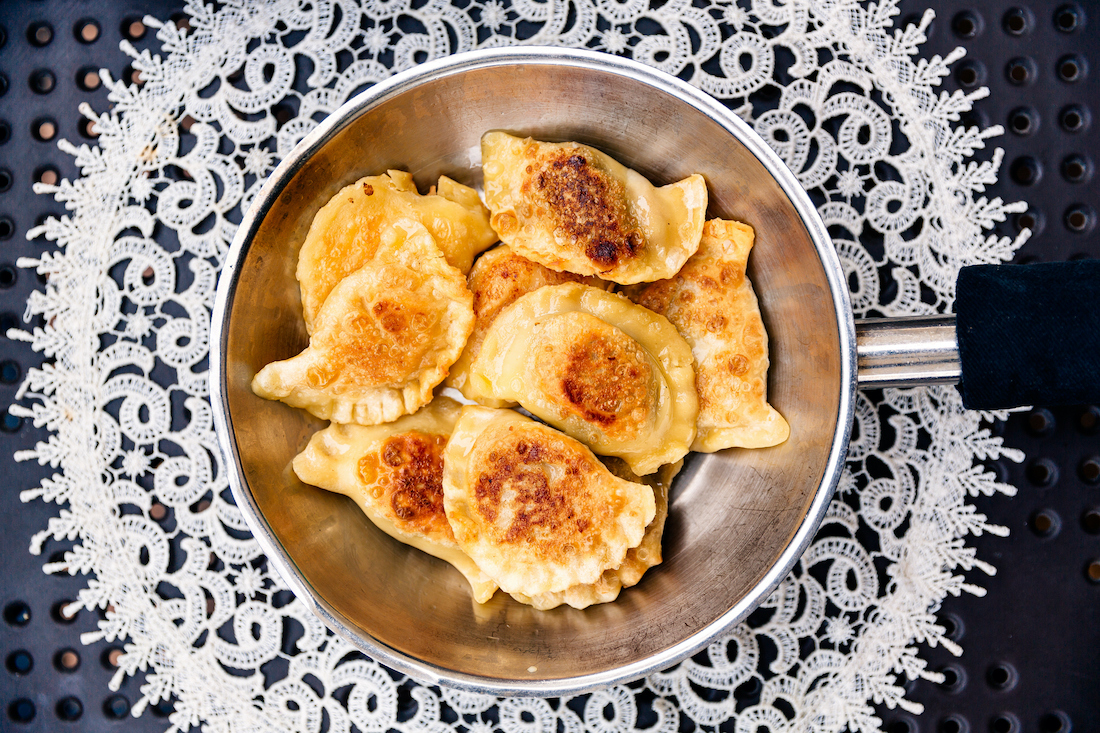Somewhere between the giant wooden duck box and the framed colored-pencil portrait of strangers' wedding vows, there’s a plate of pierogi that tastes like a cheeseburger. Not metaphorically, but literally: sesame-seeded dough stuffed with ground brisket, shredded lettuce, American cheese, onions and “max” sauce. The only thing missing is a drive-thru window.
This is Consignment Lounge, the Chicago tavern-meets-curio-shop that calls itself “an aesthetically pleasing collection of useless items for sale inside a neighborhood bar.” There, Max Glassman — known around town as Pierogi Papi — sets up shop on weekends, spinning out dumplings that feel like a dare and a love letter at the same time. Italian beef pierogi. Smoked salmon with everything-bagel dough and whipped caper mascarpone. “Grandma’s recipe with a twist,” he says.
In America, we’ve typecast the pierogi: floppy, doughy, butter-slicked, potato-stuffed. It’s a side dish. A lovable carb bomb. Nostalgic, sure, but not exactly adventurous. Maybe they show up at a church fundraiser or the freezer aisle. Maybe they get browned in butter, topped with sour cream and dutifully served next to a kielbasa. You know the story.
But pierogi weren’t born dull. In their native Poland, they’re peasant food, yes — but also celebratory, regional and wildly varied. In “Pierogi: Over 50 Recipes to Create Perfect Polish Dumplings,” author Zuza Zak writes that pierogi are “the dumplings everyone identifies with Poland,” but insists they’re also a gateway into a deeper, more diverse culinary landscape. There is a whole universe of regional cuisines,” she writes, “much of which remains undiscovered to the world at large.”
And in the hands of chefs and adventurous home cooks, that universe is getting a maximalist remix.
A clear-cut case for pierogi’s versatility? The Pierogi Experiment — a now-archived blog by Emily Rasinksi, who spent several years trying to push the dumplings into wild new territory: pumpkin pie-rogi, elote-inspired dumplings stuffed with spiced corn and cheese, even a jalapeño popper riff. The site, which ran until 2022, felt part-laboratory, part-family scrapbook.
Rasinski grew up making pierogi with her Polish-American family, hundreds at a time each Christmas Eve. “We stuck to the classics: potato + cheese and sauerkraut,” she wrote. But as an adult, she got curious. Why stop there? “Fusions are all the rage in modern cooking and dining,” she wrote. “What if we took the old world classic and brought it into the 21st century?”
We need your help to stay independent
She also added a note to the wary: “Disclaimer: if you are a pierogi purist, this blog may not be for you. While we will be exploring some traditional pierogi (both family recipes as well as some classics), many of the recipes on this blog are going to take you out of your comfort zone. Will all the recipes be good? I doubt it. Some might be down right weird. But that’s the point.”
What Rasinski captured isn’t just culinary experimentation. It’s the spirit of play. Of reverence and rebellion, held in the same palm-sized pocket of dough.
Not every remix needs to be loud.
In “Fresh from Poland: New Vegetarian Cooking from the Old Country,” Warsaw-based author Michal Korkosz offers a quieter evolution of pierogi — one that leans into elegance rather than audacity. Think: lentils and sun-dried tomatoes folded into dough, or blueberry-stuffed pierogi served with honeyed sour cream. They’re deeply rooted in tradition, but tilted gently toward the present.
“It may seem strange to you that this Polish cuisine cookbook does not contain meat,” Korkosz writes in his introduction. “For many, Poland is associated with pork schnitzel and kielbasa sausage, often served with cold vodka. It's true that in the canon of Polish cuisine there are truly stunning meat-based dishes, but here I would like to show my homeland from a different angle. Our valleys are rich in wonderful fruits and vegetables, the culture of dairy products and fermented foods is incredibly advanced, and the number of grain-based dishes is countless.”
His pierogi are humble and radiant at once — an invitation to see the form not as a leftover, but a canvas. A chance to reconsider not just the dumpling, but the story we tell about what Polish food is, though the pierogi rethink doesn’t stop at fillings. It’s also about how we eat them.
In a weeknight-friendly sheet-pan recipe for the New York Times, cookbook author Hetty Lui McKinnon tosses frozen pierogies with Brussels sprouts and kimchi, roasting them until the dumplings are crisp and golden, the sprouts blistered, and the kimchi sticky and caramelized. She finishes the dish with a dill sour cream for balance, though she encourages swapping in whatever tangy dairy you’ve got in the fridge — Greek yogurt, crème fraîche, even buttermilk.
It’s fast, funky, and deeply satisfying. And it’s also quietly radical: pierogi as dinner solution, not just cultural nostalgia. A format, not just a food.
Even Reddit is packed with inventive pierogi hacks. People use them as the base for nachos (bonus points for crispy kielbasa crumbles), or smother them in gravy and cheese curds for a makeshift poutine. One thread suggested layering them in a baking dish with tomato sauce and mozzarella — “lazy lasagna,” they called it — turning pierogi into something reminiscent of culurgiones, the Sardinian stuffed pasta, just with a heavier Midwestern accent.
At some point, you have to ask: If you swap the fillings, change the dough, crisp them in the oven, layer them like pasta, drown them in gravy — are they still pierogi, or have we slipped into Ship of Theseus territory?
But maybe that’s the wrong question. Because what pierogi are, what they’ve always been, is a vehicle. For comfort, for nostalgia, for a little culinary mischief. Whether they’re stuffed with brisket and “max” sauce, glazed in kimchi caramel, or tucked into a lasagna pan, the point isn’t purity. The point is joy. And if they’re delicious? That’s reason enough to keep going.


